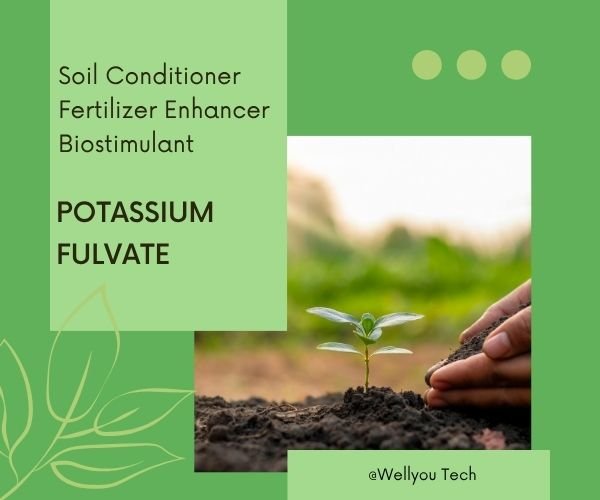1. PRODUCT OVERVIEW
Potassium Fulvate Flakes is a 100% water-soluble organic potassium salt extracted from high-grade weathered coal or lignite. It is rich in low molecular weight fulvic acid and medium molecular weight humic acid, with excellent chelation and bioactivity. This product improves soil physical and chemical properties, enhances plant nutrient absorption, and supports sustainable agricultural practices. It is particularly effective as a soil conditioner in various types of degraded or nutrient-deficient soils.
2. TYPICAL ANALYSIS
| Item | Specification |
| Fulvic Acid (dry basis) | ≥ 50% |
| Humic Acid (dry basis) | ≥ 50% |
| Water Solubility (dry basis) | ≥ 99% |
| Moisture | ≤ 15% |
| pH (1% aqueous solution) | 8 – 11 |
| Appearance | Black to brown flakes |
| Source | Natural Leonardite |
3. KEY BENEFITS AS A SOIL CONDITIONER
- Improves Soil Structure:Enhances soil porosity and aggregation, increases water holding capacity, and improves aeration.
- Enhances CEC:Boosts the cation exchange capacity of soil, promoting better nutrient retention and availability.
- Buffers pH & Salinity:Helps regulate soil pH and reduces the harmful effects of soil salinity and heavy metals.
- Stimulates Microbial Activity:Provides carbon sources and stimulates beneficial microbial populations in the rhizosphere.
- Chelates Nutrients:Increases the availability of micronutrients (Fe, Zn, Mn, Cu) by chelation, especially in alkaline soils.
- Improves Fertilizer Efficiency:Reduces nutrient leaching and enhances uptake of NPK and trace elements.
4. RECOMMENDED APPLICATION
1) Soil Application (Base or Top Dressing)
- Dosage:5–10 kg/ha per application
- Frequency:2–3 applications per crop cycle
- Method:Mix with organic or conventional granular fertilizers, or apply directly to soil and incorporate.
2) Drip Irrigation / Fertigation
- Dosage:2–5 kg/ha per application
- Dilution Ratio:1:500 – 1:1000 with irrigation water
- Frequency:Apply every 2–3 weeks depending on crop needs
3) Blending with Fertilizers
- Can be blended with NPK, calcium nitrate, urea, etc.
- Avoid mixing with acidic products below pH 4 to prevent reaction or sedimentation
4) Soil Reclamation / Saline Soil Treatment
- 10–20 kg/ha for initial soil recovery programs
- Combine with organic matter or compost for better results
5. CROP SUITABILITY
| Crop Type | Benefits |
| Vegetables | Improves root mass and quality, reduces nitrate leaching |
| Fruits | Enhances sugar accumulation, color, and storage life |
| Field Crops | Increases yield stability and nutrient efficiency |
| Horticulture & Turf | Strengthens root system and stress tolerance |
| Greenhouse Crops | Compatible with fertigation systems |
6. PACKAGING & STORAGE
- Packaging Options:1 kg / 5 kg / 20 kg kraft paper bags with PE liner or customized bags
- Shelf Life:3 years if stored properly
- Storage Conditions:Store in a dry, ventilated place, away from moisture and direct sunlight
- Handling Note:Reseal tightly after use. Avoid contact with eyes and prolonged skin exposure.
7. SAFETY & TOXICITY
- Non-toxic, environmentally friendly
- Safe for humans, animals, and beneficial soil microbes
- Does not cause chemical residues or pollution
8. COMPATIBILITY
Potassium Fulvate Flakes is highly compatible with most fertilizers and agrochemicals, but special care should be taken when mixing with concentrated solutions of multivalent cations such as calcium (Ca²⁺), magnesium (Mg²⁺), and iron (Fe³⁺), as precipitation or flocculation may occur under certain pH conditions.
Detailed Guidelines:
✅ Compatible with:
- Urea, ammonium nitrate, potassium nitrate
- NPK compound fertilizers (neutral to slightly alkaline)
- Trace elements (chelated or sulfate forms)
- Most biostimulants and microbial products
Weakly alkaline pesticides
⚠Use caution with:
Calcium or Magnesium solutions (e.g. Ca(NO₃)₂, MgSO₄):
- Avoid direct mixing in concentrated form.
- If necessary, dilute both products separately before mixing.
- Apply immediately after preparation to avoid sedimentation.
High pH or low pH mixes:
Fulvic substances are stable in pH 4–11, but extreme conditions may reduce solubility.
Phosphates or sulfates in hard water:
Hard water can cause scaling or floc formation when combined with phosphate or sulfate fertilizers.
❌ Do not mix with:
- Strong acids (e.g., nitric acid, sulfuric acid)
- Highly acidic fertilizers with pH < 4
- Lime sulfur or Bordeaux mixture
- Copper-containing fungicides (unless fully chelated)
Recommendation:
Always perform a jar test before large-scale mixing. Observe for any flocculation, color change, or sedimentation. If using drip irrigation or fertigation, filter the final mix through a 60–80 mesh screen to avoid clogging.


